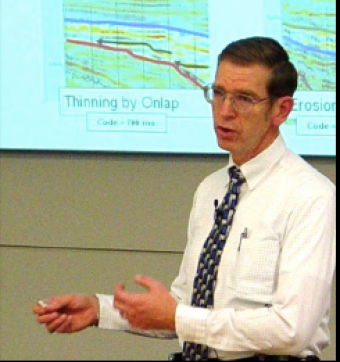1h 5min Advanced
In this lesson, students will discover how scientists in the oil and gas industry risk a prospect. A manager wants to know what we think is the most likely volume of HC we expect, and the chance that this prospect will actually have that amount of HC. The bigger the possible “prize,” the more risk the manager would be willing to take on. What are the steps that petroleum geoscientists take to examine what the play will produce?
This lesson should be divided into three (3) segments. Review the previous exercise (Exercise 13), introduce the lecture material, and then present the exercise. The review of Exercise 13 has five (5) slides, and will take ~8 minutes to explain. The lecture material contains thirty-two (32) slides, and will take ~45 minutes to explain. The introduction to Exercise 14 has ten (10) slides, and takes around twelve (12) minutes to explain.
Exercise 14 is best done in the same teams as Exercises 12 and 13. The teams will use the time structure map that they generated in Exercise 13, and estimate the average radius for the 900 ms contour. The teams should calculate the diameter in the long orientation and the diameter in the short orientation to find the average radius.
The exercise instructions are a “cookbook” to come up with the risked estimated ultimate recovery (EUR). If the students did Exercise 10b, they should have no trouble. If you did not have them do Exercise 10b, the instructions may not be quite so clear. It should take a team no more than about twenty (20) minutes to complete this exercise.
At the end of this lesson, students should be able to:

This course, based on teaching material from Dr. Fred Schroeder (formerly of Exxon/ExxonMobil), reflects on the geology and geophysics basics for the petroleum industry. General geology and basic geophysics are not required, but helpful with the material.

This course, based on teaching material from Dr. Fred Schroeder (formerly of Exxon/ExxonMobil), reflects on the geology and geophysics basics for the petroleum industry. General geology and basic geophysics are not required, but helpful with the material.
We encourage the reuse and dissemination of the material on this site as long as attribution is retained. To this end the material on this site, unless otherwise noted, is offered under Creative Commons Attribution (CC BY 4.0) license